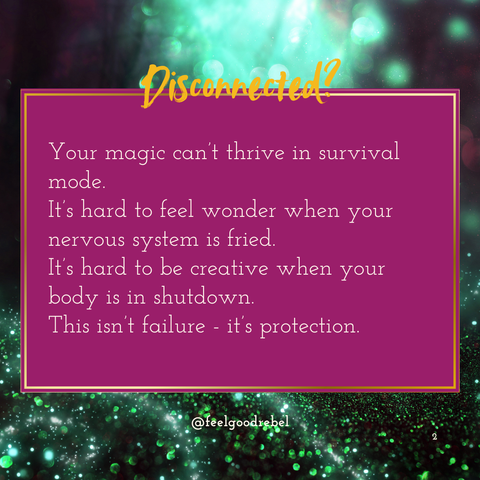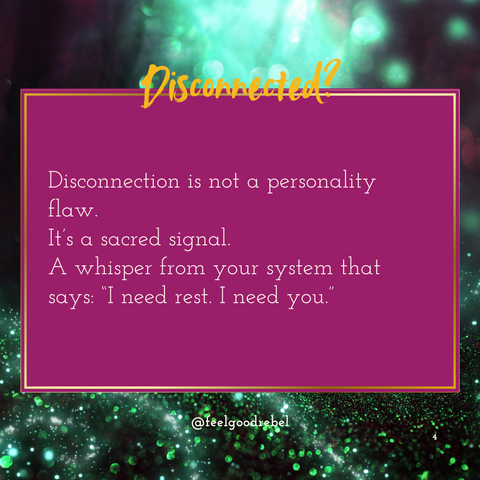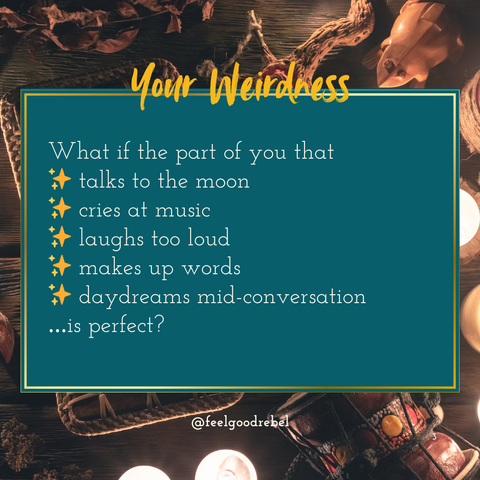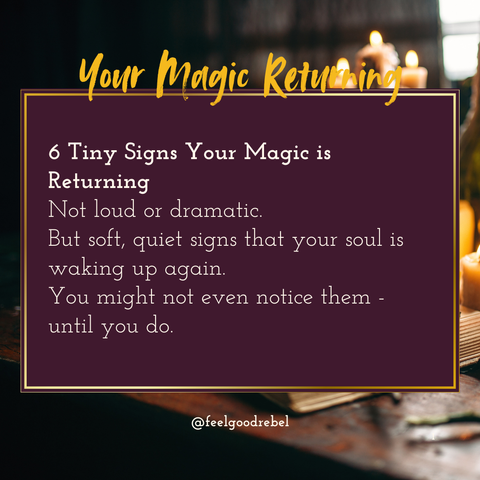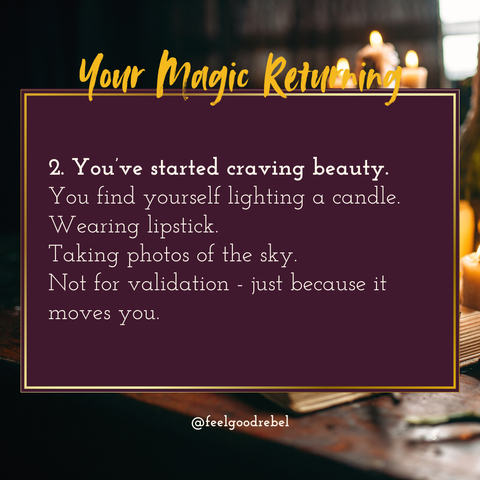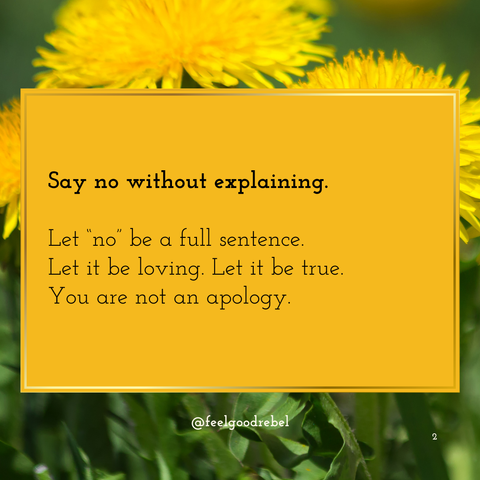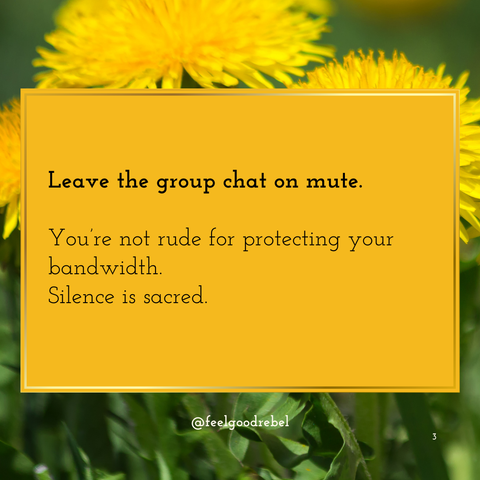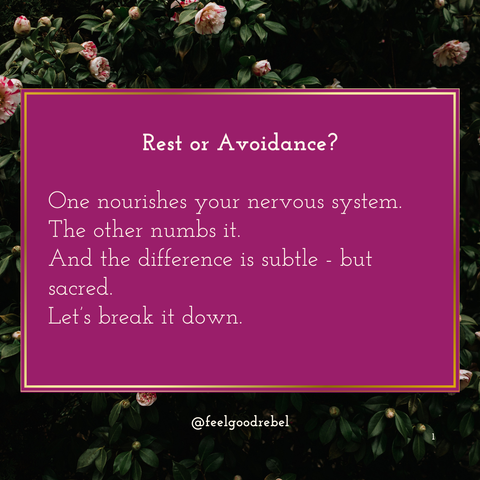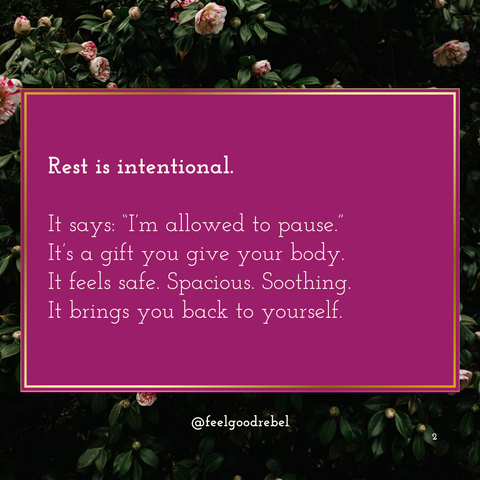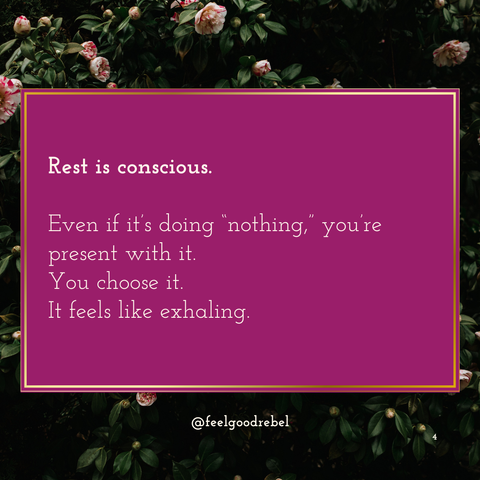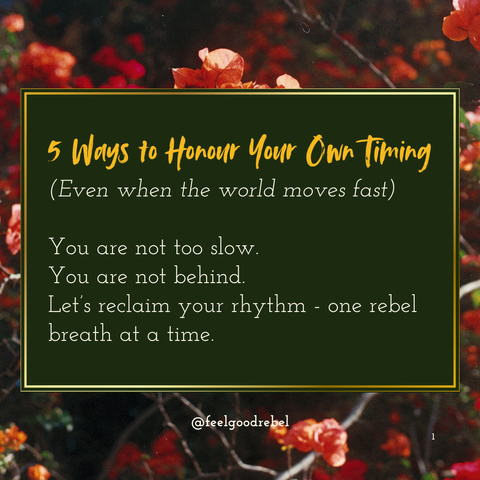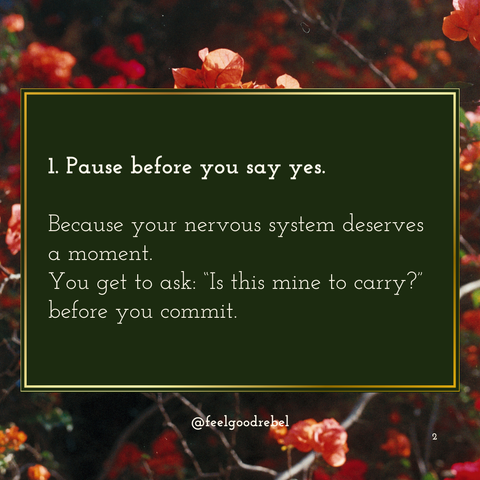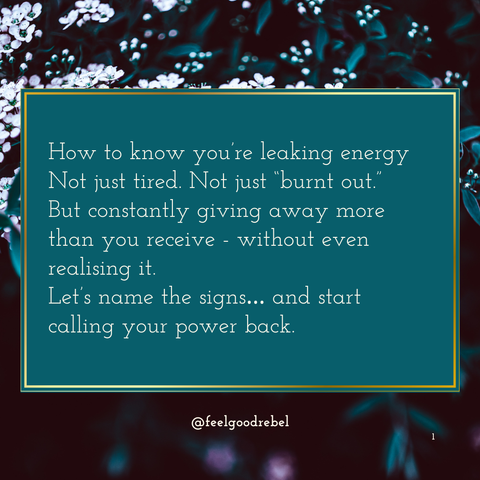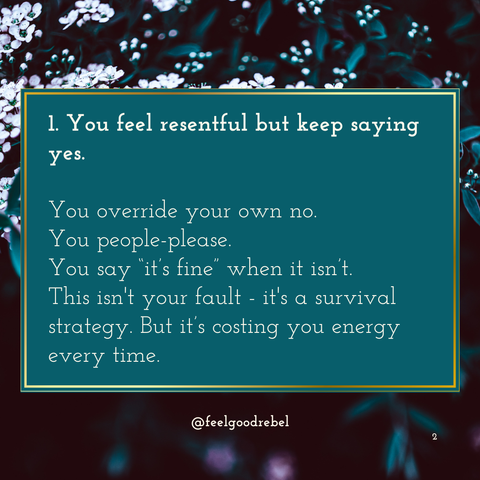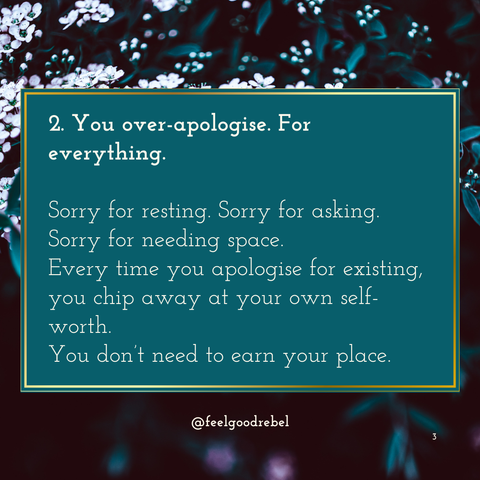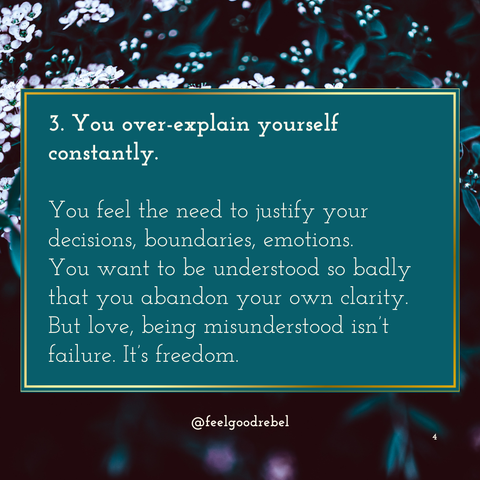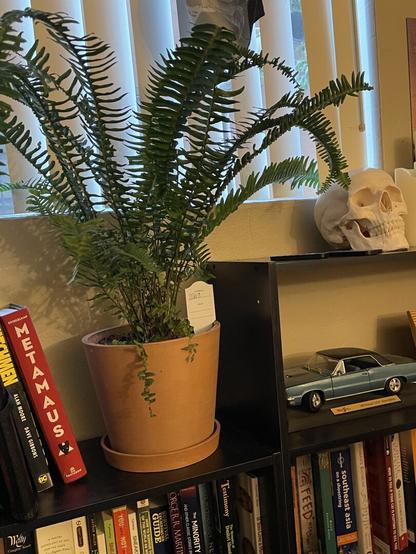What if boundaries aren’t about pushing people away…
but about showing them how to love you better?
What if they’re not rejection - but relationship?
We’ve been taught that saying no means we’re selfish.
That asking for space makes us difficult.
That choosing ourselves is somehow unkind.
But the truth is that sacred boundaries are a love language.
They say:
✨ “I want to stay connected, but not at the cost of myself.”
✨ “I trust you enough to be honest.”
✨ “This is what care looks like for me.”
And yes - setting them might feel shaky at first.
But over time, they become the very thing that protects your softness. Your energy and your magic.
Inside today’s post, I’m sharing a reframe and a few boundary phrases you can actually use - even if your voice shakes.
Even if you’ve been taught to overgive.
Even if you’re scared of being “too much.”
✨ You are allowed to protect your peace.
✨ You are allowed to be both kind and clear.
✨ You are allowed to say no and still be full of love.
And if you’re craving a space where that gets to be your normal...
Worthy & Rising is open.
Free. Healing. Made for you.
Link’s in bio, love.
#sacredboundaries #feelgoodrebel #worthyandrising #gentlerebellion
#boundarieswithoutburnout #selfsovereignty #selfdevotion #reclaimyourenergy
#nervoussystemhealing #highlysensitivewoman #softrebellion #emotionalresilience
#rebelmagic #selftrustjourney #restrevolution #spiritualselfcare
#softrebellion
If you’ve been feeling disconnected from your magic lately…
...not creative, not inspired, not you...
I want you to know this:
It’s not because you’ve failed.
It’s not because your magic disappeared.
It’s because your nervous system is tired.
Your body’s been protecting you.
Your soul has been whispering: “Please slow down. I miss you.”
You’re disconnected because you’ve been surviving.
And magic doesn’t bloom when we’re constantly bracing.
What brings it back isn’t hustle or pressure - but presence.
The sacred pause.
The soft breath.
The tiny yes to yourself.
✨
Inside today’s post, I’m naming the real reason so many magical humans feel flat, foggy, or distant from their spark -
and offering gentle ways to come home again.
You don’t have to wait to feel magical.
You already are.
And if you’re craving a space to reconnect to that truth...
Worthy & Rising is open.
Free. Healing. Made for you.
Link’s in bio, love. Come exhale with us.
#youarethemagic #worthyandrising #feelgoodrebel #selfsovereignty
#nervoussystemhealing #gentlerebellion #restrevolution #spiritualselfcare
#highlysensitivewoman #slowgrowthmovement #selftrustjourney
#healingburnout #embodimentpractice #reclaimyourenergy #softrebellion
#emotionalresilience #rebelmagic
...not creative, not inspired, not you...
I want you to know this:
It’s not because you’ve failed.
It’s not because your magic disappeared.
It’s because your nervous system is tired.
Your body’s been protecting you.
Your soul has been whispering: “Please slow down. I miss you.”
You’re disconnected because you’ve been surviving.
And magic doesn’t bloom when we’re constantly bracing.
What brings it back isn’t hustle or pressure - but presence.
The sacred pause.
The soft breath.
The tiny yes to yourself.
✨
Inside today’s post, I’m naming the real reason so many magical humans feel flat, foggy, or distant from their spark -
and offering gentle ways to come home again.
You don’t have to wait to feel magical.
You already are.
And if you’re craving a space to reconnect to that truth...
Worthy & Rising is open.
Free. Healing. Made for you.
Link’s in bio, love. Come exhale with us.
#youarethemagic #worthyandrising #feelgoodrebel #selfsovereignty
#nervoussystemhealing #gentlerebellion #restrevolution #spiritualselfcare
#highlysensitivewoman #slowgrowthmovement #selftrustjourney
#healingburnout #embodimentpractice #reclaimyourenergy #softrebellion
#emotionalresilience #rebelmagic
What if your weirdness is the very thing we’ve been waiting for?
The part you hide in job interviews.
The part you shrink at family dinners.
The part that’s too sparkly, too sensitive, too intense, too much…
What if that is the portal to your magic?
You weren’t born to be polished.
You weren’t born to be a carbon copy of the people who feel “safe” to follow.
You were born to be recognisably you.
Loud laugh. Awkward stories. Cosmic obsessions. Sacred rage.
The whole thing.
And yes - some people won’t get you.
Some might leave.
But your people will lean in.
They’ll say “me too.”
They’ll exhale when you finally let yourself be real.
This is your reminder that you don’t have to tone it down to be magnetic.
You just have to be true.
And if you want a space where your weirdness is celebrated...
where your sacred, strange, soulful self is met with love...
Worthy & Rising is open.
Free. Soft. Real. Link’s in bio.
#youarethemagic #worthyandrising #feelgoodrebel #selfexpressionjourney
#softrebellion #gentlerebellion #selfsovereignty #highlysensitivewoman
#sacredweirdness #reclaimyourenergy #spiritualselfcare #authenticliving
#rebelmagic #restrevolution #comeasyouare #selftrustjourney
The part you hide in job interviews.
The part you shrink at family dinners.
The part that’s too sparkly, too sensitive, too intense, too much…
What if that is the portal to your magic?
You weren’t born to be polished.
You weren’t born to be a carbon copy of the people who feel “safe” to follow.
You were born to be recognisably you.
Loud laugh. Awkward stories. Cosmic obsessions. Sacred rage.
The whole thing.
And yes - some people won’t get you.
Some might leave.
But your people will lean in.
They’ll say “me too.”
They’ll exhale when you finally let yourself be real.
This is your reminder that you don’t have to tone it down to be magnetic.
You just have to be true.
And if you want a space where your weirdness is celebrated...
where your sacred, strange, soulful self is met with love...
Worthy & Rising is open.
Free. Soft. Real. Link’s in bio.
#youarethemagic #worthyandrising #feelgoodrebel #selfexpressionjourney
#softrebellion #gentlerebellion #selfsovereignty #highlysensitivewoman
#sacredweirdness #reclaimyourenergy #spiritualselfcare #authenticliving
#rebelmagic #restrevolution #comeasyouare #selftrustjourney
To my darling friend,
If you’ve been feeling disconnected lately...
like you’ve lost your spark, or forgotten who you are underneath the noise...
I want you to know:
You didn’t fail.
You didn’t fall behind.
You just forgot for a moment how holy you are.
You’ve been holding so much.
Trying to stay soft in a world that doesn’t always make it easy.
You got tired. You went quiet. You disappeared into the doing.
And maybe you thought your magic disappeared with you.
But it didn’t.
It’s still here, just patiently waiting for your permission to return.
You don’t need to earn your way back to yourself.
You only need to remember.
And if you want a space to remember more often...
a gentle place where your tenderness is welcome and your weirdness is holy:
Worthy & Rising is open.
Come breathe again. Link in bio.
I love you.
#youarethemagic #worthyandrising #feelgoodrebel #softrebellion
#reclaimyourmagic #restrevolution #selfsovereignty #spiritualselfcare
#hspcommunity #selfdevotion #selftrustjourney #healingjourney
#comehome #slowgrowthmovement #gentlerebellion #rebelmagic
If you’ve been feeling disconnected lately...
like you’ve lost your spark, or forgotten who you are underneath the noise...
I want you to know:
You didn’t fail.
You didn’t fall behind.
You just forgot for a moment how holy you are.
You’ve been holding so much.
Trying to stay soft in a world that doesn’t always make it easy.
You got tired. You went quiet. You disappeared into the doing.
And maybe you thought your magic disappeared with you.
But it didn’t.
It’s still here, just patiently waiting for your permission to return.
You don’t need to earn your way back to yourself.
You only need to remember.
And if you want a space to remember more often...
a gentle place where your tenderness is welcome and your weirdness is holy:
Worthy & Rising is open.
Come breathe again. Link in bio.
I love you.
#youarethemagic #worthyandrising #feelgoodrebel #softrebellion
#reclaimyourmagic #restrevolution #selfsovereignty #spiritualselfcare
#hspcommunity #selfdevotion #selftrustjourney #healingjourney
#comehome #slowgrowthmovement #gentlerebellion #rebelmagic
Your magic doesn’t always return with trumpets and fireworks.
Sometimes it tiptoes back in like a friend who never stopped loving you, just waiting for you to notice.
It’s in the way you start laughing again, with your whole chest.
It’s in the way you pause to admire the clouds, buy yourself flowers, or light a candle just because it makes you feel.
It’s in the tiny acts of rebellion…
like resting without apology, or saying no without a novel-length explanation.
If any part of you has felt far from yourself lately, let this be a reminder:
You’re just remembering.
And every small moment where you choose softness, beauty, or truth...
that’s your magic. That’s you, returning to yourself.
✨
If you want a space where these tiny wins are celebrated,
where your growth gets to be gentle and joyful:
Worthy & Rising is open.
Free. Sacred. Yours.
Link’s in the bio, love.
#youarethemagic #worthyandrising #feelgoodrebel #gentlerebellion
#selfsovereignty #restrevolution #spiritualselfcare #highlysensitivewoman
#reclaimyourenergy #selftrustjourney #softrebellion #magicisreal
#embodimentpractice #healingfromburnout #slowgrowthmovement
#emotionalresilience #selfleadershipjourney
Sometimes it tiptoes back in like a friend who never stopped loving you, just waiting for you to notice.
It’s in the way you start laughing again, with your whole chest.
It’s in the way you pause to admire the clouds, buy yourself flowers, or light a candle just because it makes you feel.
It’s in the tiny acts of rebellion…
like resting without apology, or saying no without a novel-length explanation.
If any part of you has felt far from yourself lately, let this be a reminder:
You’re just remembering.
And every small moment where you choose softness, beauty, or truth...
that’s your magic. That’s you, returning to yourself.
✨
If you want a space where these tiny wins are celebrated,
where your growth gets to be gentle and joyful:
Worthy & Rising is open.
Free. Sacred. Yours.
Link’s in the bio, love.
#youarethemagic #worthyandrising #feelgoodrebel #gentlerebellion
#selfsovereignty #restrevolution #spiritualselfcare #highlysensitivewoman
#reclaimyourenergy #selftrustjourney #softrebellion #magicisreal
#embodimentpractice #healingfromburnout #slowgrowthmovement
#emotionalresilience #selfleadershipjourney
You don’t have to overhaul your life to reclaim your energy.
You don’t need a perfect routine, a 5-step morning ritual, or a productivity hack.
You just need one breath. One boundary. One sacred no.
🧡
This post is your permission slip:
To unplug.
To move slower.
To make choices that actually feel good in your body - not just your to-do list.
Here are a few tiny ways to reclaim your energy this week:
✨ Say no without explaining.
✨ Mute the group chat.
✨ Eat something warm.
✨ Let the mess be messy.
✨ Go outside just to be.
✨ Make one decision for you.
None of these are revolutionary.
And yet - if you really let them in...
they’ll change everything.
Because when your energy is yours again, your magic returns too.
🖤
If you’re craving more gentle rebellion, more slowness,
more spaces where you don’t have to earn your worth -
Worthy & Rising is open.
My free community for magical humans like you.
Link in bio. Come breathe again.
#nervoussystemreset #energyprotection #gentlerebellion
#feelgoodrebel #worthyandrising #highlysensitivewoman
#softrebellion #slowgrowthmovement #selfsovereignty
#healingwithouthustle #reclaimyourenergy #boundarieswithoutburnout
#ritualmagic #bodywisdom #spiritualfeminist #selfdevotion
You don’t need a perfect routine, a 5-step morning ritual, or a productivity hack.
You just need one breath. One boundary. One sacred no.
🧡
This post is your permission slip:
To unplug.
To move slower.
To make choices that actually feel good in your body - not just your to-do list.
Here are a few tiny ways to reclaim your energy this week:
✨ Say no without explaining.
✨ Mute the group chat.
✨ Eat something warm.
✨ Let the mess be messy.
✨ Go outside just to be.
✨ Make one decision for you.
None of these are revolutionary.
And yet - if you really let them in...
they’ll change everything.
Because when your energy is yours again, your magic returns too.
🖤
If you’re craving more gentle rebellion, more slowness,
more spaces where you don’t have to earn your worth -
Worthy & Rising is open.
My free community for magical humans like you.
Link in bio. Come breathe again.
#nervoussystemreset #energyprotection #gentlerebellion
#feelgoodrebel #worthyandrising #highlysensitivewoman
#softrebellion #slowgrowthmovement #selfsovereignty
#healingwithouthustle #reclaimyourenergy #boundarieswithoutburnout
#ritualmagic #bodywisdom #spiritualfeminist #selfdevotion
Ever wonder if you’re truly resting…
or just avoiding everything?
It’s a quiet difference - but a powerful one.
And it starts with how it feels in your body.
Rest says:
“I’m allowed to pause.”
It brings you back to yourself.
Avoidance says:
“I can’t handle this right now.”
It pulls you away from yourself.
And the truth is - both are valid.
Both are human.
Both deserve compassion.
You don’t need to fix yourself.
You just need to listen with love.
So today, instead of judging your scrolling or over-busy mind,
pause and ask gently:
✨ “Am I escaping or restoring?”
✨ “What would feel nourishing right now?”
✨ “Can I give myself permission to rest on purpose?”
You are worthy of care.
You are allowed to slow down.
You don’t have to earn it.
Come breathe, rebel.
And if this resonates - come join us inside Worthy & Rising,
my free community for magical humans like you. 🌙
Link is in the bio. ✨
#restrevolution #nervoussystemhealing #selfawarenesspractice
#spiritualselfcare #softrebellion #feelgoodrebel #worthyandrising
#boundarieswithoutburnout #selfsovereignty #gentlehealing
#hspcommunity #selfleadershipjourney #emotionalresilience
#sacredrest #healingfromwithin #reclaimyourenergy
or just avoiding everything?
It’s a quiet difference - but a powerful one.
And it starts with how it feels in your body.
Rest says:
“I’m allowed to pause.”
It brings you back to yourself.
Avoidance says:
“I can’t handle this right now.”
It pulls you away from yourself.
And the truth is - both are valid.
Both are human.
Both deserve compassion.
You don’t need to fix yourself.
You just need to listen with love.
So today, instead of judging your scrolling or over-busy mind,
pause and ask gently:
✨ “Am I escaping or restoring?”
✨ “What would feel nourishing right now?”
✨ “Can I give myself permission to rest on purpose?”
You are worthy of care.
You are allowed to slow down.
You don’t have to earn it.
Come breathe, rebel.
And if this resonates - come join us inside Worthy & Rising,
my free community for magical humans like you. 🌙
Link is in the bio. ✨
#restrevolution #nervoussystemhealing #selfawarenesspractice
#spiritualselfcare #softrebellion #feelgoodrebel #worthyandrising
#boundarieswithoutburnout #selfsovereignty #gentlehealing
#hspcommunity #selfleadershipjourney #emotionalresilience
#sacredrest #healingfromwithin #reclaimyourenergy
Do you feel like the world is sprinting
and you’re stuck in slow motion?
You’re not behind.
You’re just moving at the speed of truth...
At the rhythm of your real self.
Here are 5 ways to honour your own timing
(even when urgency is screaming in your ear):
1. Pause before you say yes.
2. Rest when you’re tired — not when you’ve “earned it.”
3. Celebrate the invisible wins.
4. Let yourself take longer.
5. Choose alignment over speed.
Because you’re not here to keep up - you’re here to belong to yourself.
This post is your reminder:
🌳 You get to move slow.
🌳 You get to trust your timing.
🌳 You get to rewrite the rules.
And if you’re craving more rhythm, rest, and rebellion,
join me inside Worthy & Rising - my free community for magical humans like you.
Link in bio. You belong there. 🌙✨
#slowlivingmovement #divinetiming #nervoussystemhealing #sacredslowness
#selfsovereignty #boundariesarebeautiful #hspcommunity #worthyandrising
#feelgoodrebel #selftrustjourney #gentlerebellion #softrebellion #spiritualselfcare
#healinghustleculture #restrevolution #selfleadership
and you’re stuck in slow motion?
You’re not behind.
You’re just moving at the speed of truth...
At the rhythm of your real self.
Here are 5 ways to honour your own timing
(even when urgency is screaming in your ear):
1. Pause before you say yes.
2. Rest when you’re tired — not when you’ve “earned it.”
3. Celebrate the invisible wins.
4. Let yourself take longer.
5. Choose alignment over speed.
Because you’re not here to keep up - you’re here to belong to yourself.
This post is your reminder:
🌳 You get to move slow.
🌳 You get to trust your timing.
🌳 You get to rewrite the rules.
And if you’re craving more rhythm, rest, and rebellion,
join me inside Worthy & Rising - my free community for magical humans like you.
Link in bio. You belong there. 🌙✨
#slowlivingmovement #divinetiming #nervoussystemhealing #sacredslowness
#selfsovereignty #boundariesarebeautiful #hspcommunity #worthyandrising
#feelgoodrebel #selftrustjourney #gentlerebellion #softrebellion #spiritualselfcare
#healinghustleculture #restrevolution #selfleadership
Ever feel like you’re doing all the right things…
but you still end the day feeling wrung out?
Snappy. Drained. Like your soul needs a nap?
It might not be because you’re lazy or broken or bad at life.
It might just be this:
You’re leaking energy.
Invisible ways you abandon yourself just to keep the peace.
To avoid conflict.
To be understood.
To feel “enough.”
But what if you didn’t have to keep proving your worth through exhaustion?
What if rest wasn’t a reward - but a right?
Inside this post, I’m walking you through 5 signs of energy leakage
and giving you one small, rebellious action to try today.
You don’t need to change your whole life overnight.
But you do get to take your power back, one drop at a time.
Breathe. Swipe. Reclaim your energy.
You deserve to feel like yourself again.
🌙 P.S. If this resonates, you’re exactly who I made Worthy & Rising for - my free community for rebels who are done with self-abandonment, and ready to rise into rhythm, rest, and real connection.
Come join us. You belong there.
Link in bio 🖤✨
#energyhealing #personalgrowthjourney #restisproductive #peoplepleasernomore #sovereignwoman
#nervoussystemsupport #feelgoodrebel #boundariesarebeautiful #healingjourney #softrebellion
#empoweredfeminine #reclaimyourpower #selfabandonmentrecovery #emotionalhealing
#highlysensitiveperson #sacredrest #worthyandrising #gentlehealing #spiritualfeminist #feelgoodrebelacademy
but you still end the day feeling wrung out?
Snappy. Drained. Like your soul needs a nap?
It might not be because you’re lazy or broken or bad at life.
It might just be this:
You’re leaking energy.
Invisible ways you abandon yourself just to keep the peace.
To avoid conflict.
To be understood.
To feel “enough.”
But what if you didn’t have to keep proving your worth through exhaustion?
What if rest wasn’t a reward - but a right?
Inside this post, I’m walking you through 5 signs of energy leakage
and giving you one small, rebellious action to try today.
You don’t need to change your whole life overnight.
But you do get to take your power back, one drop at a time.
Breathe. Swipe. Reclaim your energy.
You deserve to feel like yourself again.
🌙 P.S. If this resonates, you’re exactly who I made Worthy & Rising for - my free community for rebels who are done with self-abandonment, and ready to rise into rhythm, rest, and real connection.
Come join us. You belong there.
Link in bio 🖤✨
#energyhealing #personalgrowthjourney #restisproductive #peoplepleasernomore #sovereignwoman
#nervoussystemsupport #feelgoodrebel #boundariesarebeautiful #healingjourney #softrebellion
#empoweredfeminine #reclaimyourpower #selfabandonmentrecovery #emotionalhealing
#highlysensitiveperson #sacredrest #worthyandrising #gentlehealing #spiritualfeminist #feelgoodrebelacademy
I used to think routines were about fixing myself.
Now I think they’re about finding myself again.
Not to impress anyone. Not to be productive. Just to feel a little more grounded.
This week’s post is about soft mornings, imperfect habits, and showing up without the pressure to get it right.
It’s not about doing it perfectly. It’s about doing it gently.
🌿 Blog post is live – link in bio
#softrebellion #gentleroutines #cozyliving #reclaimingmyself #morningritual #slowgrowth #realselfcare #bloggerlife #intentionaldays
Now I think they’re about finding myself again.
Not to impress anyone. Not to be productive. Just to feel a little more grounded.
This week’s post is about soft mornings, imperfect habits, and showing up without the pressure to get it right.
It’s not about doing it perfectly. It’s about doing it gently.
🌿 Blog post is live – link in bio
#softrebellion #gentleroutines #cozyliving #reclaimingmyself #morningritual #slowgrowth #realselfcare #bloggerlife #intentionaldays
Soft Rebellion in Action
1. Refusing the Script of Fear
The coup depends on a narrative of helplessness, of inevitability. Soft rebellion rewrites it. It speaks in futures not yet stolen. It refuses to repeat the script that says “we are powerless.” Instead, it whispers: We are vast. We are unruly. We are not so easily governed.
2. Sanctuary Networks
Authoritarianism thrives on isolation, on making people feel like they stand alone. Soft rebellion builds underground networks of care—mutual aid, resource sharing, protection. It weaves safety where the state seeks to unravel it. This looks like organizing community bail funds, housing networks, off-the-grid communication systems. It looks like knowing who in your neighborhood needs help, who has a safe house, who can be counted on when institutions fail.
3. Disobedient Joy
The coup wants you terrified. It wants you brittle and compliant. So laugh in its face. Gather in parks, sing, dance, make art that mocks the strongman and his fragile grip on power. Remember that joy is not a distraction—it is a weapon. It reminds us that another world is possible, that we are more than the violence done to us.
4. Slowing the Machine
Capitalism and fascism walk hand in hand, demanding productivity even as the world burns. Soft rebellion opts out. It works just enough to survive, then redirects energy into resistance, into community, into slowness. It refuses to feed the machine that funds oppression. It chooses to rest when the system demands exhaustion.
5. Decentralized Resistance
The state expects rebellion to be centralized, to have leaders it can imprison, movements it can crush. Soft rebellion is fungal—it spreads, untraceable, leaderless. It moves through encrypted networks, anonymous zines, whisper campaigns. It understands that a revolution with no head cannot be beheaded.
6. Rituals of Rewilding
Fascism thrives on control—of land, of bodies, of narratives. Soft rebellion rewilds. It plants trees in vacant lots. It reclaims stolen land. It teaches foraging and rainwater collection. It remembers that resistance is not just about destruction, but about growing something back.
7. Disrupting the Spectacle
Authoritarianism is theater—it survives on attention, on outrage, on the constant churn of crisis. Soft rebellion learns when to look away, when to starve the beast. It refuses to amplify propaganda, to take every bait, to let the regime dictate the rhythm of our days. It turns its gaze instead toward the work of healing, building, dreaming.
8. Turning Disinformation Into Openings
The coup thrives on disinformation, on turning reality itself into a battlefield. But soft rebellion doesn’t waste energy fighting ghosts. Instead of arguing in bad faith arenas, it uses moments of disinformation as openings—gently rerouting conversations toward truth, planting quiet seeds of doubt in false narratives. This looks like asking questions rather than attacking, offering a story rather than a statistic, introducing facts with the ease of someone handing over a cup of water instead of a hammer. It resists not through force, but through invitation—through giving people the tools to unspool their own illusions.
Soft rebellion is not passive. It is insurgent, but in a way that cannot be easily named or neutralized. It moves in whispers, in laughter, in unnoticed refusals. It weaves a world beneath the one being forced upon us—a world that, one day, will break through the cracks and bloom.»
—Shannon Willis
#SoftRebellion #ShannonWillis
1. Refusing the Script of Fear
The coup depends on a narrative of helplessness, of inevitability. Soft rebellion rewrites it. It speaks in futures not yet stolen. It refuses to repeat the script that says “we are powerless.” Instead, it whispers: We are vast. We are unruly. We are not so easily governed.
2. Sanctuary Networks
Authoritarianism thrives on isolation, on making people feel like they stand alone. Soft rebellion builds underground networks of care—mutual aid, resource sharing, protection. It weaves safety where the state seeks to unravel it. This looks like organizing community bail funds, housing networks, off-the-grid communication systems. It looks like knowing who in your neighborhood needs help, who has a safe house, who can be counted on when institutions fail.
3. Disobedient Joy
The coup wants you terrified. It wants you brittle and compliant. So laugh in its face. Gather in parks, sing, dance, make art that mocks the strongman and his fragile grip on power. Remember that joy is not a distraction—it is a weapon. It reminds us that another world is possible, that we are more than the violence done to us.
4. Slowing the Machine
Capitalism and fascism walk hand in hand, demanding productivity even as the world burns. Soft rebellion opts out. It works just enough to survive, then redirects energy into resistance, into community, into slowness. It refuses to feed the machine that funds oppression. It chooses to rest when the system demands exhaustion.
5. Decentralized Resistance
The state expects rebellion to be centralized, to have leaders it can imprison, movements it can crush. Soft rebellion is fungal—it spreads, untraceable, leaderless. It moves through encrypted networks, anonymous zines, whisper campaigns. It understands that a revolution with no head cannot be beheaded.
6. Rituals of Rewilding
Fascism thrives on control—of land, of bodies, of narratives. Soft rebellion rewilds. It plants trees in vacant lots. It reclaims stolen land. It teaches foraging and rainwater collection. It remembers that resistance is not just about destruction, but about growing something back.
7. Disrupting the Spectacle
Authoritarianism is theater—it survives on attention, on outrage, on the constant churn of crisis. Soft rebellion learns when to look away, when to starve the beast. It refuses to amplify propaganda, to take every bait, to let the regime dictate the rhythm of our days. It turns its gaze instead toward the work of healing, building, dreaming.
8. Turning Disinformation Into Openings
The coup thrives on disinformation, on turning reality itself into a battlefield. But soft rebellion doesn’t waste energy fighting ghosts. Instead of arguing in bad faith arenas, it uses moments of disinformation as openings—gently rerouting conversations toward truth, planting quiet seeds of doubt in false narratives. This looks like asking questions rather than attacking, offering a story rather than a statistic, introducing facts with the ease of someone handing over a cup of water instead of a hammer. It resists not through force, but through invitation—through giving people the tools to unspool their own illusions.
Soft rebellion is not passive. It is insurgent, but in a way that cannot be easily named or neutralized. It moves in whispers, in laughter, in unnoticed refusals. It weaves a world beneath the one being forced upon us—a world that, one day, will break through the cracks and bloom.»
—Shannon Willis
#SoftRebellion #ShannonWillis
> .. It moves in whispers, in laughter, in unnoticed refusals. It weaves a world beneath the one being forced upon us—a world that, one day, will break through the cracks and bloom.”
--#ShannonWillis #SoftRebellion
> Like a flower blooms in asphalt
Let's talk of love in abandoned fields
--- #NanBuShiki 南部式 South Style South Way
@bsmall2@pixelfed.social
Client Info
Server: https://mastodon.social
Version: 2025.04
Repository: https://github.com/cyevgeniy/lmst





